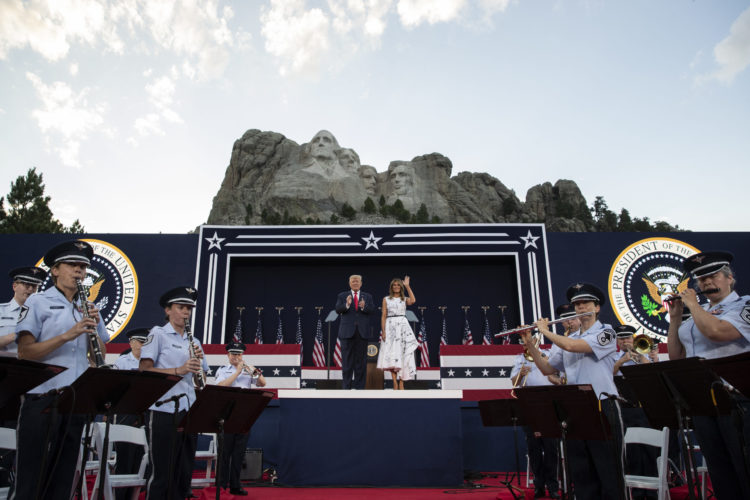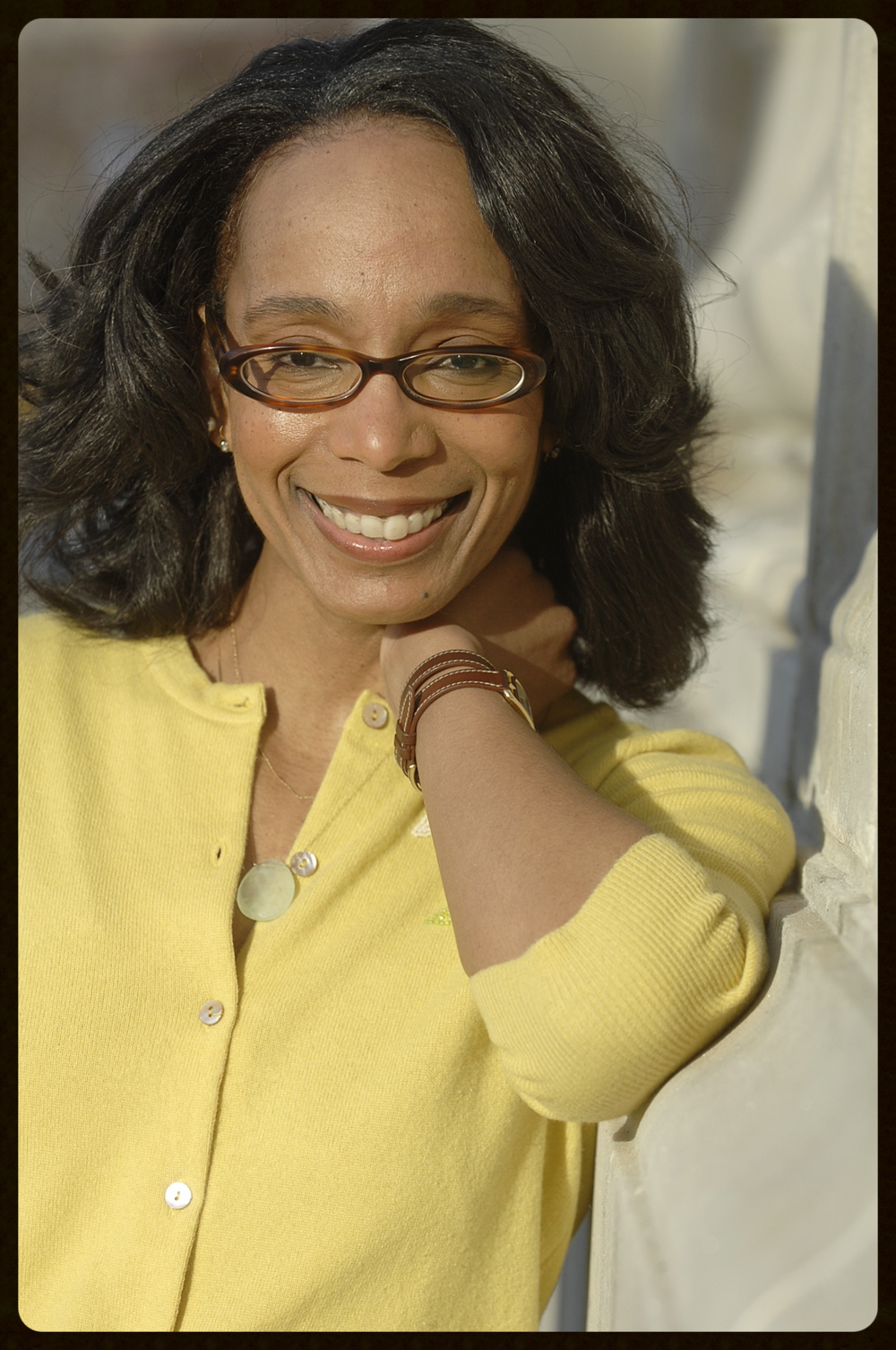
President Donald Trump, accompanied by first lady Melania Trump, stand during a ceremony at Mount Rushmore National Memorial, Friday, July 3, 2020
But Givhan didn’t waste words on the president’s attire, or a single syllable on the drape and swing of Melania Trump’s white skirt. She mentioned the “dramatic fashion” of Trump’s arrival. Beyond that, the description of Trump’s look was limited to two short sentences inside a single tight paragraph in her deadline column:
And oh, how he glowed. He wore a dark suit and red tie. An American flag pin was tacked to his lapel. His skin was dewy in the summer heat. His smile was broad.
Instead, in what has become her signature style, Givhan dished up both sharp description and biting critique of the entire event: the weather, the family members standing with Trump, the complex history of a sacred place, the show of military might, the crowd of Native American protesters who tried to block a highway entrance, and an audience that ignored any coronavirus etiquette — as did Trump’s speech.
It’s the kind of broad cultural commentary that earned Givhan a 2006 Pulitzer Prize, in which she was honored for her “witty, closely observed essays that transform fashion criticism into cultural criticism.” Among those stories was an upbraiding of Dick Cheney’s unceremonious attire at a solemn Auschwitz remembrance. During 2009-10, she covered Michelle Obama’s life as First Lady — everything from her policy rollouts to her hiking shorts. She also is the author of “The Battle of Versailles: The Night American Fashion Stumbled into the Spotlight and Made History.”
Givhan began her career at the Detroit Free Press where she made the jump from general feature writing to covering the fashion beat. With stints at the San Francisco Chronicle, Newsweek/The Daily Beast, and Vogue, she’s spent much of her writing life decoding and critiquing fashion through unique cultural takes.

Robin Givhan
Recently, she has offered additional essays from outside the fashion world that focus her keen eye and narrative style on politics and culture. It was her capture of the Mount Rushmore rally that prompted me to reach out to learn more about her work and craft. Our conversation has been edited for length and clarity.
Your career evolved from general feature writing to fashion reporting to fashion criticism. Did you have an aha! moment crystalizing how you could contextualize and bring cultural commentary to your writing or did it evolve over time?
I shifted from general features to fashion out of a desire to have a beat. I really wanted a topic that I owned and could burrow into. Fashion just happened to be the beat that opened up. I wasn’t especially interested in it, although I DID think it was an intriguing subject. When I moved from the Detroit Free Press to the Washington Post, my view of fashion broadened to include the way that public figures used attire and personal style to enhance their message or to bolster their authority.
I didn’t have an aha moment as much as it was a slow awakening to the ways in which politics permeated our lives much the same way that fashion does. The two are intertwined. I saw that in powerful ways when Hillary Clinton was first lady. One time when she testified on Capitol Hill, she was wearing a coat with a curious design on the back. TV commentators kept referring to the pattern as a “dragon.” I called her spokesperson, who sent me a close-up image of the back of her coat. The pattern was abstract. People saw what they wanted to see. The coat pattern was like a Rorschach test. That experience made me deeply curious about the ways that aesthetics shape public opinion and how context changes the way we view aesthetics.
You continue to evolve. For many years you’ve married fashion and cultural commentary (including politics) but recently you’ve published some high-profile pieces outside of the Post’s Style section. Is that in response to the many specific challenges presented in politics right now, or do you see yourself shifting to general commentary more regularly?
Periodically, I’ve spent time away from the fashion beat: writing about politics or culture at large. But my more recent pieces of commentary were really just born out of the moment. I think having spent so much of my time writing about a medium that’s so visual has honed my eye for details. And — this is when I give a shout out to liberal arts education — I think having been an English major also helps me to interpret meaning and see connections across different disciplines.
I was consumed by unfolding events and wanted to write about them in a way that captured the visceral emotions and confusion and frustrations connected to them. I noticed the profound silence during the early days of quarantine and wanted to explore that. I was dumbfounded by the choreographed stagecraft of Trump’s Tulsa rally and his speech at Mt. Rushmore and wanted to parse those moments to better understand them. And the emotional upheaval connected to George Floyd’s death and the protests were impossible to ignore. I kept thinking about the family that grieved in public and how hard that must be and yet how powerful it is for the country to see that. I hope to continue to be able to step away from fashion. Although I still enjoy covering that industry.
You have a reputation for speaking…straightforwardly. How does this serve you as a writer and how does it connect to your voice as a writer?
Frankly, I don’t know any other way to write other than, as you put it, straightforwardly. Again, coming from my experience writing about fashion for a general interest newspaper, I’m always aware that I’m not speaking to insiders. I want my stories to be as welcoming as possible and lure in those who may think they’re not interested in fashion. So I try to write in a way that’s thoughtful but not impenetrable, welcoming but not condescending. I aim to write the way I speak — but in a more polished, edited way. I also recognize that a lot of fashion coverage steers clear of blunt assessments. I think that’s silly and bad for fashion. Every industry needs its outside critics.
Speaking of audience, it seems that part of your work as a fashion (and culture) writer is decoding for us what we’re taking in. What role does your audience play in how you position your pieces?
My audience is everything. I want to take them along on a pathway that I hope my stories are clearing for them. I want to answer the unasked question. I begin with the belief that my audience is incredibly smart and thoughtful, but that it may not be deeply enmeshed in the nuances of fashion or politics or whatever the topic might be.
You also write with confidence, which is important for a critic. Does that come naturally to you, or did it build over time? What’s your experience with with editors when your take is controversial?
To my mind, confidence comes with experience. The longer I’ve reported on the industry the greater my depth of knowledge about it and my understanding of the subtleties. I don’t think you can be a good critic if you’re not a good reporter because smart criticism is based on knowledge. Anyone can spout off an opinion; the one’s that have resonance are the opinions that are based on fact. If I write about a fashion collection and say that I don’t like it, well so what? It doesn’t really matter unless I can explain why I think a collection failed in its mission — and that should be based on the realities of business, the cultural times and the goals of the brand. Good criticism isn’t personal; it’s focused on the work under consideration.
I’ve also had the tremendous gift of incredible editors who have pushed me to be precise in my writing, who have pointed out when I’m hedging in a column and who have pummeled me with really smart questions that have helped me beef up my arguments.
How much do you rely on those reporting skills for the writing you’re doing now? What kind of reporting is needed for good fashion writing? For criticism?
As I said, you can’t be a good critic without being a good reporter. Too often, fashion is viewed as a topic that requires some specialized knowledge or personality trait in order to make inroads. It has its peculiarities and its lingua franca, just like any other industry. But learning it is just a matter of asking questions, building sources, being curious, showing up, listening. And then writing about it as fairly and directly as possible. For all the gloss that coats fashion, ultimately it’s a pretty gritty, grueling, competitive business. If you understand that, if you remember that, it really helps you put a lot of things into perspective and understand what motivates the different players and why they make the decisions that they do.
I’m a big fan of your descriptive metaphors. In your recent piece on Trump’s Mount Rushmore rally, you wrote:
Friday night, in an amphitheater in the shadow of Mount Rushmore, a military band played smooth jazz on snare drums and trumpets as the country sank under the rising number of coronavirus infections.
For me, that conjured up an image reminiscent of the Titanic. You refer to Trump’s talking points as his “campaign cherry bombs.” In a 2005 story you wrote about John Roberts’ Supreme Court nomination, you piled on the “syrupy” descriptors about the event and his family’s style choices:
…a trio of Easter eggs, a handful of Jelly Bellies, three little Necco wafers.
Do you have a process for coming up with or refining your descriptions? How do you know when you’ve found the right phrase?
Thank you for noticing that Titanic reference!
In an odd way, writing about fashion is a really good exercise in expanding your descriptive abilities. How many times can you just say “dress” or “shirt” or “coat” in a story? Those words don’t really convey what’s on a runway. You have to work harder to give people an understanding of what something looks like and you have to do that quickly, on deadline. So I think I’ve probably gotten used to having to come up with evocative ways to describe a garment, a setting or a person in a relatively short amount of time.
I tend to like groups of three. I like the rhythm of hitting a note three times. Sentences have a melody to them and I tend to read stories — or parts of them — aloud so I can hear the rhythm. You sort of know when a sentence needs another beat.
Like every writer, I love words. It delights me when a great word pops into my head — one that doesn’t get as much use as perhaps it should. The story itself inspires phrases. The reference to cherry bombs in the Mt. Rushmore story obviously came from my thinking about the upcoming fireworks. Sometimes a phrase is born out of an intense desire to avoid the cliché that came to mind first. I ask myself: What’s another way, a better way, of saying that. The Roberts’ family description came, in large measure, because I really like candy! Seeing them in a row in all their pastels conjured up that image.
Finally, who do you read/who are you reading right now for inspiration?
- Frank Bruni, New York Times. He is a friend. And I am profoundly jealous of his vocabulary.
- Margaret Sullivan, Washington Post. Her sweeping knowledge of how an industry works.
- Jesmyn Ward, for the poetry in her sentences.
Audra Jenkins is an academic advisor and adjunct journalism instructor at the University of Missouri.


